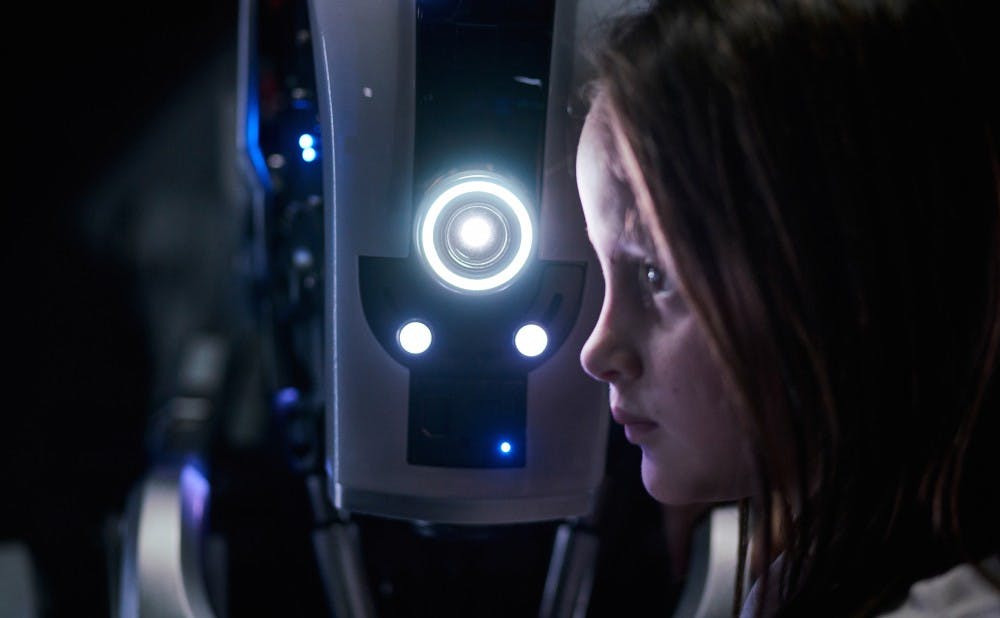At such a technologically tumultuous moment in time, it seems that a piece of techno sci-fi media emerges from the mind of a technological conspirator every second. As more tech users become suspicious of technology’s increasingly tighter grip, whether it be through fears of Elon Musk-operated simulations or Big Data, this uneasiness is being more frequently expressed through more cynical sci-fi cinema. However, this trope has the potential to be either too pessimistic or optimistic, too prescriptive or unorthodox. With so much media amassing on the issue, it is rare to come across something that strikes a graceful balance.
The highly anticipated “I Am Mother,” which premiered at Sundance this January, took a unique perspective on this otherwise overdone story. Directed by first-time filmmaker Grant Sputore, the Australian thriller tells the story of a young girl raised by artificial intelligence in a post-apocalyptic world.
Daughter (Clara Rugaard) has lived her whole life in an underground bunker with Mother, an anthropomorphic robot who is tasked with the feat of repopulating the earth by means of a whole lab full of test-tube babies. Rose Byrne voiced Mother, but Luke Hawker, who helped develop the robot, was inside the suit during filming. Daughter lives in ignorant bliss until a distressed woman (Hilary Swank) disrupts this reality when she barges into the bunker, seeking shelter from the outside world. The rest of the film follows Daughter’s internal struggle between trusting a human stranger over her mechanized mother.
Although the plot, a story of conflicting ethics in a cataclysmic universe, is certainly familiar, “I Am Mother” distinguishes itself in its relevant critique of the ways in which technology is becoming seamless to the human experience. The mother-daughter relationship between the two main characters was a clever way to explore the shifting power dynamics between humans and machines. Most human-robot relationships currently depicted in film are either romantic (“Ex Machina,” “Her,” “Wall-e”), between friends who are roughly equal or feature a familial relationship between an older, more mature human and younger machine (“A.I. Artificial Intelligence”).
Bestowing an automated being with the role of eternal mother who bears the responsibility of recreating mankind is a statement in and of itself.
The film could be suggesting that, as humans depend on technology more and more to fulfill basic aspects of our anthropology — interpersonal relationships, knowledge acquisition, the lens with which we see the world (Twitter providing us with political perspectives, Instagram shaping the way we see ourselves and others, etc.) — we implicitly fall into the role of child to our parental technology, which provides for us and upon which we depend. Whereas many other cyber science fictions focus on the way humans exert themselves onto technology, “I Am Mother” switches the locus of control onto the artificial intelligences which seem to be claiming more and more power in our culture, both ideologically and pragmatically, a perspective that has come to be known as technological determinism. Although these philosophical quandaries are certainly raised in the film, they are not pushed religiously down the throats of viewers, which allows for more of an exploratory experience rather than a feeling of being lectured, as many science fictions have been known to do.
During a Q&A following the Sundance premiere, director Grant Sputore said that he “wanted to make a film that people would talk about,” and not necessarily provide direct answers.
“I think we all watch what’s going on in the world at the moment and get a little worried about the existential chances of humanity,” Sputore said. “And robots will either save us from that or expedite it. [The film] is a discussion and rumination on that.”
As humans come to rely more and more on technology, habitually and subconsciously, critical art deserves consideration as a nuanced, relevant mode of questioning our culture. However, if these bodies of art place blame or chastise through a disguise of self-righteous Puritanism, they will only push audiences — who very personally rely on technology — further away, and make the appropriate (and necessary) questioning of our dependence on technology seem ill-intentioned. Instead, analytic pieces like “I Am Mother” should be carefully digested and evaluated by wide and diverse audiences for the ways in which they reflect upon our complicated relationship with technology, which could use some serious examination.
Get The Chronicle straight to your inbox
Signup for our weekly newsletter. Cancel at any time.

